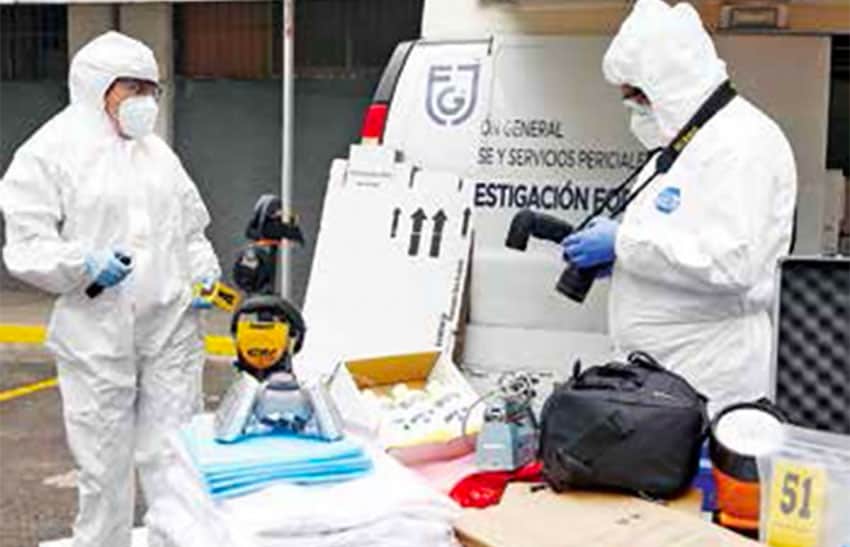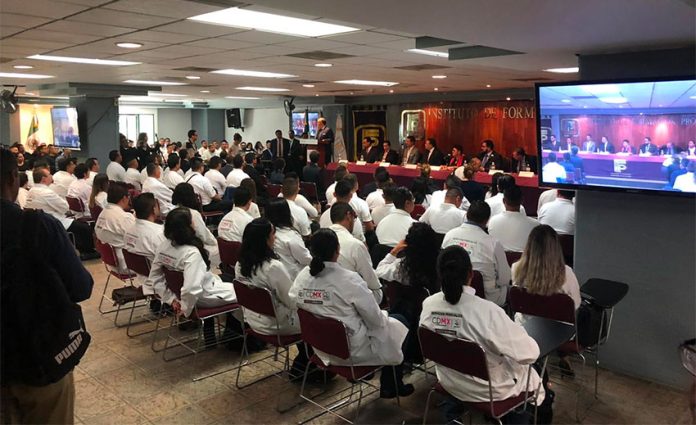There are few positive narratives about Mexico’s criminal justice system. Appalling treatment of victims, alarming figures of impunity, and pervasive violations of due process are central themes of most assessments of the country’s law enforcement institutions.
It is hardly surprising, then, that many citizens choose simply not to report crimes and that distrust of the system is widespread.
If the need for change is urgent, the path to reform is less clear. A large-scale reform in 2016 made state attorneys general offices autonomous, and rearranged internal processes and structures around oral trials that aimed to protect victims and defendants alike. Both the federal government and foreign aid agencies supported this effort with extensive budgetary and technical assistance.
Other interventions intended to reduce impunity included specific training for police and prosecutors on the basic aspects of criminal procedures and trials, criminal investigation techniques, construction of dedicated infrastructure for holding trials, processes for certifying forensic laboratories, and increases in technological capacity, among many others.
However, these assessments and interventions seldom took into account two factors that in the long run determine the effectiveness, efficiency and sustainability of criminal justice reform efforts.
The first factor is the perspective of law enforcement personnel. That is, getting to know first-hand what challenges each actor faces on a day-to-day basis and what happens when dramatic policy shifts such as the oral trial reform upset institutional inertia.
The second factor relates to assessment and metrics. Simply put, the lack of data — and insufficient record keeping — has made it difficult to evaluate the results and impact of interventions. Because there is a shortage of evidence available to key stakeholders, it is difficult to replicate successful experiences and identify failing ones.
The result is that efforts to reduce impunity begin to feel like an unattainable quest: The Holy Grail of justice.
How these obstacles might be overcome is revealed in an examination of Mexico City’s Unidades Criminalísticas de Proximidad or UCPs. These units have their origin in the structural transformation of Mexico City’s Attorney General’s Office from “Procuraduría” to “Fiscalía,” a reform that made the institution autonomous from city government and aspired to improve its nefarious reputation with residents. Created after consultations with the French Embassy in 2019, the UCPs (perhaps best translated as “local investigative units”) offered a novel solution to many longstanding problems.
The specialized units only investigate intentional homicides and are deployed in areas where statistics show higher rates of violent crime. Comprised of a police commander, detectives, forensic experts and a prosecutor who oversees the legality of procedures, they are intended to provide a response that is both immediate and streamlined, improving the odds of a successful investigation.
Key aspects of the initiative include the increasing the leadership role granted to detectives, simplifying administrative inefficiencies during initial investigations, and coordinating investigations and prosecutions by improving teamwork between officers, forensic experts, and prosecutors. Crucially, this emphasis on investigation of crimes challenges traditional patterns of policing in Mexico that have rarely succeeded in resolving crimes when the perpetrator was not arrested in flagrante.

Currently there are two fully operational UCPs in Mexico City, one in Iztapalapa, at the eastern edge, and the other in the northern Gustavo A. Madero district. There are three more partially operational UCPs in the central, southern, and western areas of the city. There are currently 85 detectives, 28 forensic specialists, 28 photography experts, and six prosecutors working across these five units.
During the program’s initial rollout, the National Citizens Observatory (ONC) took on the role of monitoring, reporting, evaluating and learning — an effort perhaps better termed “citizen accompaniment.” Our participation has enabled us to observe and document strategic meetings among decision makers and training workshops for officers, track the process of case files, and visit the physical premises where investigations take place. Our approach has allowed us to identify bottlenecks and challenges faced by members of the UCPs, as well as specific gaps in training.
In two years, we have thus been able to gain an inside perspective on how intentional homicides are investigated from a local perspective and how can a simple organizational innovation like the UCPs have achieved some minor, yet meaningful milestones. This experience challenges reductionist narratives of criminality that call for tougher punitive measures, misguided expectations of forensic investigations resulting from the “CSI Effect” and, perhaps most significantly, the belief that the most important cause of impunity is corruption.
From a personnel perspective, we have observed three important effects of the UCPs:
The first is that officers and criminologists have experienced attitudinal and behavioral changes towards the investigation process. Prosecutors were initially skeptical, likely a result of having to adapt to a new process where they no longer were in charge of leading investigations. Now, they arrive at the crime scene at the same time as detectives, share the same working space, and collaborate more closely. From a relational perspective, this reduces information asymmetries and incentivizes cooperation toward achieving a common goal.
Another behavioral change we have documented is the increasing proactivity of police officers. Before the reform, they were described as uncreative and passive. Each investigation was ordered by the prosecutors through bureaucratic requisitioning orders called “oficios” that were sent to police and forensic officials. During the implementation of the UCPs, police officers had to take the initiative, and though they were at times tripped up by technical and logistical details, they became fully convinced of their leading roles.
One example of this proactive behavior can be found in the citizen accompaniment report published last February. Obtaining surveillance videos from the city’s Public Safety Ministry is typically an informal process between detectives and the responding police officers. Before the UCP intervention, detectives stated that even though this sort of evidence existed, they seldom knew where to start and how to continue the investigation whenever there was a vehicle involved. Now, the Eastern UCP examines data from Automatic Number Plate Recognition (ANPR) scanners to calculate the offender’s escape routes from the crime scenes.
In one case, Commander Enríquez (who sadly died of Covid-19 last December), helped his team access surveillance imagery to reconstruct the escape route of the criminals. However, since the footage had certain blind spots, Enríquez instructed the team to calculate the approximate speed of the vehicle between one camera location and another one. Thanks to this procedure, the team narrowed down the number of possible vehicles and thus were able to identify the owner from the plate recognition device.
Lastly, the effects we have identified so far also stretch to forensic investigators. Traditionally, they were considered little more than photographers of crime scenes, “corpse lifters,” and evidence baggers but now are acknowledged as key collaborators by their peers. Some of them have acknowledged that the procedural trifecta has become a “dream come true,” while others believe that the UCP’s specialization in homicides benefits their professional growth because it has allowed them to focus on one kind of crime scene.
Have these changes in institutional culture produced results? It is too early to say. Fortunately, the design and implementation of the UCPs could allow for more systematic data collection regarding outcomes. Because the units streamline the investigative process from the moment the crime is committed to an eventual arrest, precise metrics could be obtained to compare how this model works relative to areas where UCPs are not present. One goal of the accompaniment program led by the ONC will be to develop such a system. This will allow us to examine more granular data about what drives impunity, and focus on practical solutions rather than sweeping rhetoric.
One final area of innovation surrounding the UCPs concerns their origins, and the ways in which technical assistance and foreign aid might be more effectively implemented.
French support for the project was of a very different nature than orthodox foreign aid programs, not only in its informality but in its process. Crucially, French consultants first sought to understand conditions within the Mexico City Fiscalía before suggesting actions and involving other stakeholders. At the outset, many stakeholders worried that the technical assistance would not be attuned to the city’s context. Besides the obvious differences in crime rates between the two countries, observers pointed to the differences in the structure of justice institutions and the institutional culture.
One commenter offered the analogy that large scale foreign aid programs were like trying to fit a huge sofa in a 70-square-foot living room. Most of these differences are true, but the French staff were sensible enough to customize the assistance activities and eventually, both the decision makers and the UCPs’ staff internalized and adjusted the project.
Moreover, the assistance has been largely free of geopolitical tension, and did not involve withholding financial resources pending outcomes. Isolating technical assistance from political factors and individual personalities within the embassy ensured neutrality and contributed to the program’s rapid implementation.
Two years after the project was launched, the reforms have begun to take root. The UCPs have demonstrated that change is not only necessary, but possible. Yet it remains essential to document this process, with all of its challenges: too often we ignore the organizational drivers of impunity, and miss social and behavioral perspectives from within security institutions that would better inform the life cycle of public policies.
Manuel Vélez is the director of research at the National Citizens Observatory. Follow him on Twitter at @VelezManuel.
